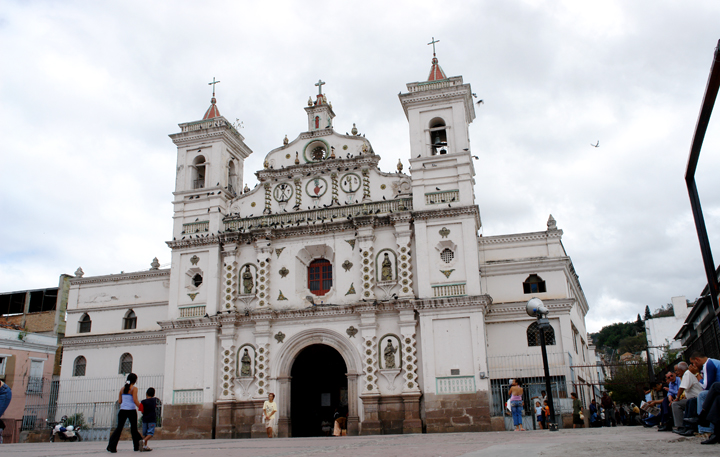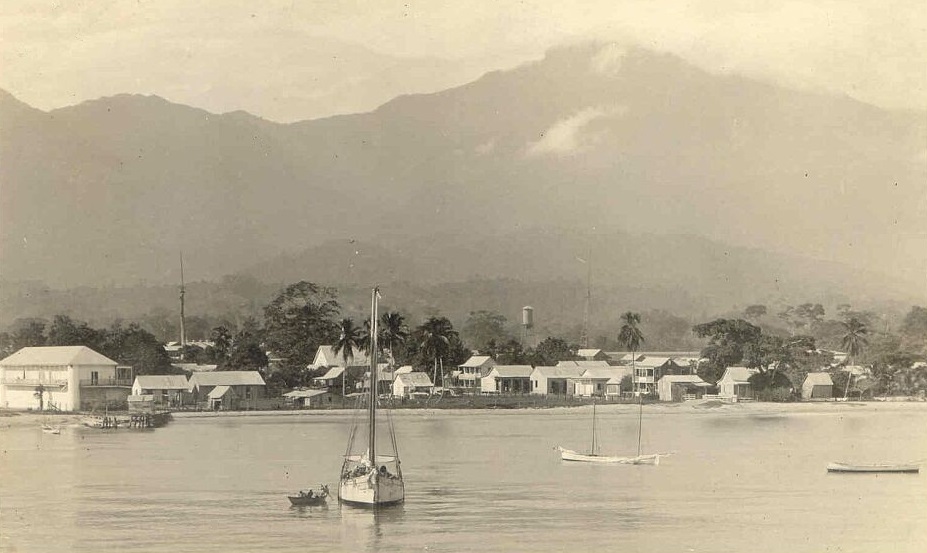|
2002–03 Honduran Liga Nacional
The 2002–03 season in the Liga Nacional de Fútbol de Honduras, Honduran Liga Nacional was the 37th edition since the intervention of the professional league in Football in Honduras, Honduran football. The season was divided into two halves (Apertura and Clausura) which ran from August 2002 to June 2003. 2002–03 teams * ''Real Maya changed its name to Real Patepluma for the Clausura tournament and moved to Santa Bárbara, Honduras, Santa Bárbara.'' Apertura The Apertura tournament lasted from August to December 2002, C.D. Olimpia defeated C.D. Platense in the Final to secure its 16th league title. Regular season Results : ''As of 24 November 2002'' Standings Final round Semifinals =Platense vs Real España= ---- * ''Platense won 2–1 on aggregate score.'' =Olimpia vs Marathón= ---- * ''Olimpia won 2–1 on aggregate score.'' Final =Platense vs Olimpia= ---- * ''Olimpia won 3–2 on aggregate.'' Squads Jose Gonzales Top goalscorers 15 goal ... [...More Info...] [...Related Items...] OR: [Wikipedia] [Google] [Baidu] |
Liga Nacional De Fútbol Profesional De Honduras
Liga Nacional de Fútbol Profesional de Honduras, known as Liga Hondubet for sponsorship reasons (''Honduran National Professional Football League'') is the highest division of domestic Association football, football in Honduras. The league season is divided into Apertura and Clausura, Opening (autumn) and Closing (spring). One team is relegated to the Honduran Liga Nacional de Ascenso, Liga de Ascenso (the team with fewest points in Opening and Closing) and one team is promoted from Honduran Liga Nacional de Ascenso, Liga de Ascenso. The top four clubs participate in play-offs to decide the champion. History In the 1930s, football experienced a surge in popularity in the country. In 1948 with the birth of the Francisco Morazán Major Football League, the idea to organize football began to take shape. Club Deportivo Olimpia, Olimpia, C.D. Federal, Federal, F.C. Motagua, Motagua, C.D. Argentina, Argentina and Real C.D. España, Real España are the pioneers of the Liga Mayor. In ... [...More Info...] [...Related Items...] OR: [Wikipedia] [Google] [Baidu] |
Tegucigalpa
Tegucigalpa ( )—formally Tegucigalpa, Municipality of the Central District ( or ''Tegucigalpa, M.D.C.''), and colloquially referred to as ''Tegus'' or ''Teguz''—is the capital and largest city of Honduras along with its sister city, Comayagüela. Claimed on 29 September 1578 by the Spanish colonization of the Americas, Spaniards, Tegucigalpa became the Honduran capital on 30 October 1880, under President Marco Aurelio Soto, when he moved the seat of government from Comayagua, which had been the Honduran capital since its independence in 1841. The 1936 constitution established Tegucigalpa and Comayagua as a Central District, and the current 1982 Honduran Constitution continues to define the sister cities as a #Central District, Central District that serves as the permanent national capital. Tegucigalpa is located in the southern-central highland region known as the Departments of Honduras, department of Francisco Morazán Department, Francisco Morazán of which it is also t ... [...More Info...] [...Related Items...] OR: [Wikipedia] [Google] [Baidu] |
Estadio Olímpico Metropolitano
Estadio Olímpico Metropolitano is a multi-purpose stadium in San Pedro Sula, Honduras. It is currently used mostly for football matches and also has facilities for athletics. It has a capacity of 37,325. History It was built in 1997 for the sixth edition of the Central American Games held there. This stadium was built by Jerónimo Sandoval, mostly known by "Chombo Sandoval", he was the organizer of the 1997 Central American Olympic Games in San Pedro Sula, which caused many controversies. After its completion the stadium became the largest in the country dispatching Estadio Nacional's of that title. It has been the home for Honduras national football team since the 1998 FIFA World Cup qualification, with Estadio Nacional hosting some games on and off. Upon Sandoval building the stadium, he noticed that the front of the stadium displayed a large "H" by coincidence. When this was discovered, the figure was painted blue to represent the colours of the Honduras national football ... [...More Info...] [...Related Items...] OR: [Wikipedia] [Google] [Baidu] |
Cortés Department
Cortes, Cortés, Cortês, Corts, or Cortès may refer to: People * Cortes (surname), including a list of people with the name ** Hernán Cortés (1485–1547), a Spanish conquistador Places * Cortes, Navarre, a village in the South border of Navarre, Spain * Cortes de Aragón, Teruel, a municipality in the province of Teruel, Aragón, Spain * Cortes, Bohol, a municipality in the Philippines * Cortes, Surigao del Sur, a municipality in the Philippines * Cortês, a municipality in Pernambuco, Brazil * Puerto Cortés, a seaport in Honduras * Cortés Department, a department in Honduras * Cortes Island, an island in British Columbia, Canada * Cortes, Aberdeenshire, a village in Scotland, United Kingdom Institutions * Cortes of Cádiz, former parliament of Spain * Cortes Generales, the parliament of Spain * Aragonese Corts, the regional parliament for the Spanish autonomous community of Aragon * Cortes of Castile-La Mancha, the legislature of the Autonomous Community o ... [...More Info...] [...Related Items...] OR: [Wikipedia] [Google] [Baidu] |
Clásico Moderno (Honduras)
El Clásico Moderno (The Modern Classic) also referred by some as the Clasico Moderno Hondureño is a Honduran football match played at least 4 times a year in the Honduran Liga Nacional and consists of two teams, Olimpia and Real España. The Clásico Moderno is the most fierce derby played in Honduras. The two "Barras" (MegaBarra and Commando 12 from España and Ultra Fiel from Olimpia) confront themselves with deadly results almost every time they meet. It is considered the most aggressive, violent and the strongest rivalry in Honduran soccer. During the 1970s, 1980s, and early 1990s it was considered without doubt the greatest derby of the Honduran football, during these 25 years both team won a total of 16 championships (9 Olimpia and 7 Real España), 3 during the 1970s for both teams, 4 for Olimpia and 2 for Real España during the 1980s, and 2 for both during the early 1990s. During the late half of this decade, time during which Olimpia has won 2 Championships and Rea ... [...More Info...] [...Related Items...] OR: [Wikipedia] [Google] [Baidu] |
Motagua And Real España Football Rivalry
The Motagua River () is a river in Guatemala. It rises in the Western Highlands of Guatemala and runs in an easterly direction to the Gulf of Honduras. The Motagua River basin covers an area of and is the largest in Guatemala. The Motagua River valley contains sources of jadeitite, which has been used by many Indigenous communities that have inhabited the region. The Motagua River is also one of the most plastic-emitting rivers in the world, contributing around two percent of global plastic pollution emissions into oceans annually. Conservation efforts have been driven by the government and non-governmental organizations to ensure safe water and clean oceans. Course The river begins in the Western Highlands of Guatemala and runs along the Atlantic slope. Traveling in an easterly direction, it passes through 14 of Guatemala's departments and contains seven distinct ecoregions. Along its course, water flows in from 29 other major rivers. The final few kilometres of the riv ... [...More Info...] [...Related Items...] OR: [Wikipedia] [Google] [Baidu] |
Honduran Superclásico
The Clasico Capitalino (Capital's Derby), also known as the local derby played between F.C. Motagua and C.D. Olimpia. These two teams lead the Honduran Football League as most frequent holders of the championship trophy, and their rivalry is the biggest one in the country. Olimpia wears the white uniform, with blue and red highlights. Their mascot is a lion. Olimpia is the oldest team in the league and holds the largest number of championship titles. Motagua wears a navy blue uniform. It is nearly as old a team as Olimpia. Motagua’s mascot is an eagle and has the second largest number of championship titles. The rivalry is so big that in 1949 Carlos Valladares' uniform was burned on the field because he left Motagua to play with Olimpia. The first ever recorded Superclásico was a friendly played on 12 March 1929, when Motagua prevailed 2–1. The first official match was played on 8 August 1965, with Olimpia winning 3–0. ''All stats accurate as of match played 6 N ... [...More Info...] [...Related Items...] OR: [Wikipedia] [Google] [Baidu] |
Clásico Sampedrano
El Clásico Sampedrano (The Sampedran Derby) is a Honduran football match played at least 4 times a year in the Honduran Liga Nacional and consists of two teams, Marathón and Real España. These two teams are from San Pedro Sula San Pedro Sula () is the capital of Cortés Department, Honduras. It is located in the northwest corner of the country in the Sula Valley, about 50 kilometers (31 miles) south of Puerto Cortés on the Caribbean Sea. With a population of 701, ..., hence the name. Head to head All time scorers : ''As of 31 October 2020'' * Carlos Pavón for Real España with 10 goals. * Gilberto Machado for Marathón with 8 goals Finals Since the creations of Finals, there have been three Sampedran derbies, two won by Real España, and one by Marathón. Trivia * This is the Honduran derby that has been played in the most cities. * Real España dominates the derby by far, but the resurgence since 2000 by Marathón has brought a new mentality for their sup ... [...More Info...] [...Related Items...] OR: [Wikipedia] [Google] [Baidu] |
Clásico Nacional Hondureño
El Clásico Nacional ("National Classic") is a Honduran football match played between Olimpia and Marathón. The Classic began in September 1928 when Olimpia, at that time Central Zone champion, won its three match final series against Marathón, champion of the North. This event created the fierce Clásico Nacional. Head to head The Finals Olimpia and Marathón have played 9 finals. Six won by Olimpia and 3 won by Marathón. 1987-88 Honduran Liga Nacional ---- ---- * ''Olimpia won 1–0 on aggregate.'' 2001-02 Clausura ---- * ''Marathón won 4-2 on aggregate.'' References Nac {{NorthAm-footy-competition-stub ... [...More Info...] [...Related Items...] OR: [Wikipedia] [Google] [Baidu] |
Santa Bárbara, Honduras
Santa Bárbara, with a population of 30,690 (2023 calculation), is the capital city of the Santa Bárbara Department, Honduras, Santa Bárbara Department of Honduras and the municipal seat of Santa Bárbara Municipality. Demographics At the time of the 2013 Honduras census, Santa Bárbara municipality had a population of 41,736. Of these, 72.45% were Mestizo, 22.00% White Latin Americans, White, 2.41% Indigenous peoples of the Americas, Indigenous (2.01% Lenca, 0.29% Chʼortiʼ people, Chʼortiʼ), 1.50% Afro-Hondurans, Black or Afro-Honduran and 1.64% others. Health The Santa Bárbara Hospital is located in the North Quarter of the city. Since 1957 it has served people from both the Santa Bárbara Department and the department of Lempira. Food Typical foods of the region are chilate, ticuco, atol of corn, chicken and pork tamales, yucca with chicharrón, torrejas, and horchata. Economy This city is known for crafts and the cultivation of coffee. The local economy depends most ... [...More Info...] [...Related Items...] OR: [Wikipedia] [Google] [Baidu] |
La Ceiba
La Ceiba () is a municipality, the capital of the Honduran department of Atlántida (department), Atlántida, and a port city on the northern Caribbean coast in Honduras. It forms part of the southeastern boundary of the Gulf of Honduras. With an estimated population of 232,696 living in approximately 170 residential areas (called ''colonias'' or ''barrios''), it is the fourth most populous municipality in the country. It was also one of several important ports during colonial times for exporting goods like sugar and gold to Spain and importing enslaved Africans to Honduras. La Ceiba was officially founded on 23 August 1877. The city was named after a giant ceiba tree that grew near the old dock. The city has been officially proclaimed the "Eco-Tourism Capital of Honduras," as well as the "Entertainment Capital of Honduras". Every year, on the third or fourth Saturday of May, the city holds its La Ceiba Carnival, famous carnival to commemorate Isidore the Laborer (Spanish ''San ... [...More Info...] [...Related Items...] OR: [Wikipedia] [Google] [Baidu] |


